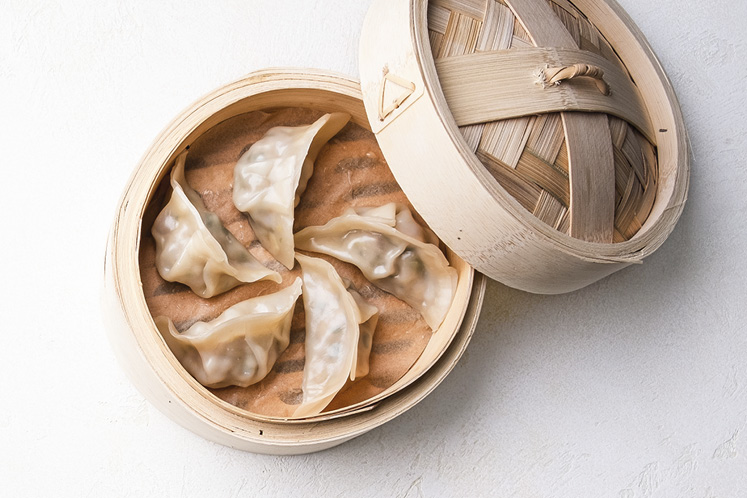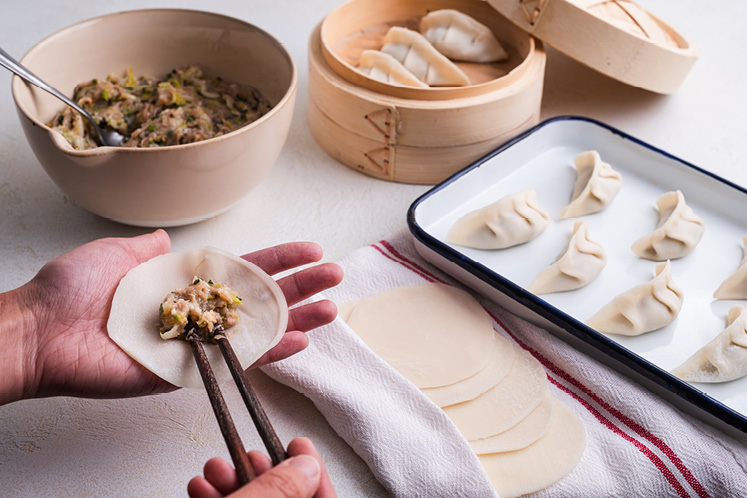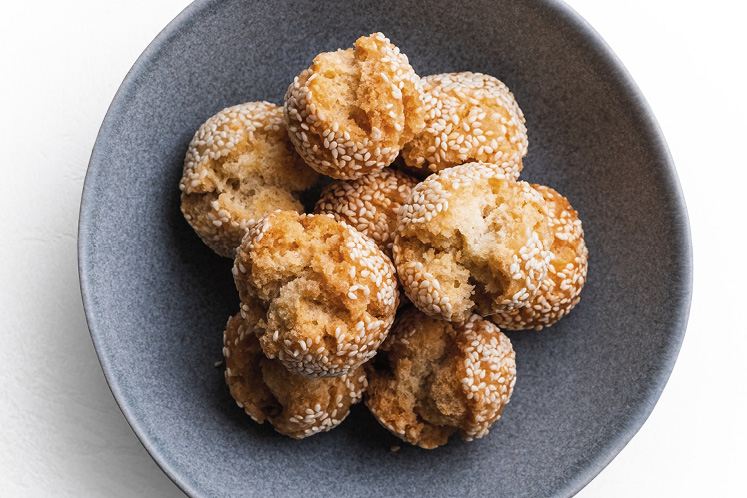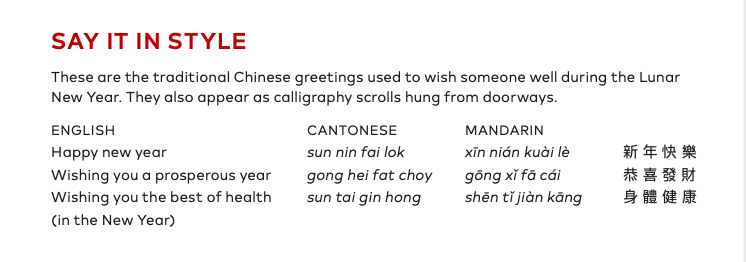A Feast to Ring in the Year of the Dragon
Dumplings shaped like half moons start in a menu inspired by the tasty traditions – and midwinter optimism – of lunar new year celebrations.
As Lunar New Year kicks off across China each year, it’s as though everything shines in auspicious red and gold. In some places, red lanterns line the sidewalks, and dancers in enormous dragon and lion costumes parade through the streets. In others, the scent of incense lingers in the air – and fireworks light up the night sky.
Yet for Elaine Li, who hails from Guangzhou, a bustling metropolis in southern China, her fondest memories of the holiday are of a cozier, indoor variety. “Every Lunar New Year’s Eve we would have a dinner party with the family – it’s the biggest dinner of the year!” A food scientist and photographer, who now calls Orangeville home and is a regular contributor to this magazine, Elaine adapted and photographed the three recipes on these pages.
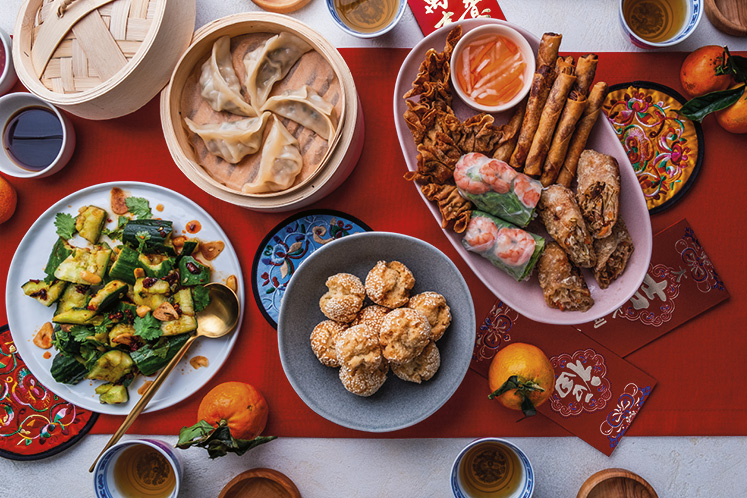
Elaine prepared dumplings, smashed cucumber salad and laughing sesame balls for this issue of In The Hills, complemented by an assortment of goodies catered by Auntie Joy’s Springrolls in Orangeville (top right). Photo by Elaine Li, Crave and Capture.
“When my grandparents were around,” she says, “they usually hosted the dinner and would spend the entire day cooking up a storm with the help of my aunt and uncle. We grandkids would come in early to ‘help,’ meaning lots of taste tests. My grandma was very good at making traditional new year desserts, such as steamed rice cakes.”
The Lunar New Year, which marks the first new moon of the lunar calendar, is one of the world’s largest and oldest festivals, celebrated by up to two billion people in China, Southeast Asia and many Asian communities around the world. The exact date of the festival varies from year to year, but it always falls sometime in January or February.
The new moon also ushers in a fresh Chinese Zodiac sign. Each year of the 12-year cycle is represented by a different animal; 2023 is the Year of the Rabbit. On February 10, 2024, the Year of the Dragon – the only mythical creature of the zodiac and considered especially auspicious – officially begins. (The Lunar New Year is, of course, one of many moon-centric late-winter celebrations. In British Columbia, for instance, many First Nations, including the Nisga’a, celebrate Hobiyee, which traditionally interprets the final crescent moon and predicts how bountiful the spring harvest season will be.)
Because the Lunar New Year has strong agrarian roots, it’s also known as the Spring Festival. Historically, this is the time of year when people prayed to the gods for a good and bountiful harvest, as well as health, wealth and longevity for their families. Foods that represent these themes include dumplings, spring rolls, fish, fruit, noodles, and rice balls or rice cakes.
The details vary depending on regional customs and rituals. Lunar New Year is celebrated in different ways in China, Hong Kong, Taiwan, Malaysia, Singapore, Vietnam and the Philippines to name a few. But there are many common traditions, such as giving your home a deep clean, wearing red, decorating with flowers and potted fruit trees, and giving small red envelopes of crisp cash to youngsters. On the 15th day, the holiday officially comes to an end with lantern festivals that often draw families to enjoy evening strolls together so they can admire the illuminated lanterns lining the streets.
For those who celebrate and those curious to learn more, the Fung Loy Kok Institute of Taoism in Mono holds an annual indoor lantern festival, using elaborately decorated electric lanterns. Open to the public, next year’s event will be held on Saturday, February 24, and will be especially significant as the centre is also marking its 40th anniversary in Mono.
“During the lantern festival, we chant prayers and attach blessings to the lanterns that energize and motivate us to create harmony, peace and light for ourselves, our families and the world,” says Gordon Young, the centre’s manager. “Everyone is welcome to visit the temple and receive blessings for things like health, prosperity or travel in the new year, and you can also take a blessing home.”
Consider Elaine’s menu a perfect meal to share the same day as the lantern festival – or anytime, really. She’s confident anyone can pull it off. The dumplings and sesame cookies are adapted from blogs run by foodies she admires, including the Chinese Canadian Christie of Christie at Home and the Australian-based Wok & Kin, which focuses on Chinese-Vietnamese cuisine. “I chose these recipes because they’re approachable, fun to make, and the ingredients are easy to find locally,” she says.
Pork and Cabbage Dumplings
“Dumplings are a quintessential Lunar New Year dish,” says Elaine. “Sometimes my mom would host gatherings with the extended family, and she would ask guests to come early to make dumplings together, so it’s very interactive (and informal), and a fun family bonding activity. It’s also very easy on the hosts because all they have to do is to prepare the fillings ahead of time. The short cooking time also helps.”
MAKES ABOUT 50–55 DUMPLINGS
4 cups thinly sliced napa cabbage
2 tsp kosher salt (to salt the cabbage)
1 lb ground pork (or ground chicken)
¼ cup shiitake mushrooms, stems removed, and diced
⅓ cup cilantro, roughly chopped (about 2 stalks)
⅓ cup green onions, thinly sliced (about 2 stalks)
2½ tbsp soy sauce
2 tbsp sesame oil
2 tsp cornstarch
1 tbsp garlic, minced
1 tsp ginger, minced
½ tbsp sugar
¼ tsp ground white pepper
1 lb (50–55 pcs) store-bought dumpling wrappers
In a large bowl, combine thinly sliced napa cabbage and kosher salt and let sit for 10 minutes to drain excess water. Rinse salted cabbage in cold water and squeeze out the liquid as best as you can.
In a large mixing bowl, combine all ingredients for the filling, including the cabbage from the previous step. Mix until the filling is fully combined and a little sticky.
Have a small bowl of water nearby. To assemble, put a dumpling wrapper in the palm of your hand and place about 1 tbsp of filling in the centre of the wrapper. To keep the dumpling wrappers moist, cover with a clean kitchen towel or plastic wrap. Use your index finger to dab a little water along the rim of the wrapper to help with sealing, and fold the wrapper over to form a half-moon shape. Then pinch and fold the edges until well sealed.
TO STEAM: Place dumplings in a steamer basket lined with parchment paper over boiling water and steam for 8 to 10 minutes over medium-high heat.
TO PAN FRY: Place a little vegetable oil in a non-stick frying pan over medium-high heat until the oil just starts to smoke. Place the dumplings in the pan, flat side down, and sear until a lightly golden-brown crust forms on the bottom of the dumplings, about 2 to 3 minutes. Add enough water to fill the pan about a half-inch deep, cover with a tight-fitting lid and steam until the water is almost cooked off, about 6 to 7 minutes. Remove the lid and continue to sear the dumplings until the water has completely steamed off and the bottoms of the dumplings are crispy and slide easily around the pan.
TO BOIL: Bring a pot of water to a rolling boil over high heat, place the dumplings in the pot, bring the water back to a boil, and boil for about 6 to 8 minutes, stirring occasionally to avoid sticking.
PRO TIPS: If using other vegetables high in moisture for the fillings, salt them in the same way as the cabbage to draw out excess moisture before mixing with other ingredients. If using hardier vegetables, such as carrots and leeks, soften them first by lightly sautéing.
Freshly made dumplings freeze well. Layer with parchment paper to avoid sticking. When cooking, add about 5 more minutes than when cooking from fresh.
Smashed Cucumber Salad
“This is super fun to make, because you get to gently release your frustrations by pounding the cucumbers,” laughs Elaine. “The smashing creates nooks and crannies in the cucumber flesh so that it can soak up lots of delicious dressing, and at the same time, creates different textures within each bite. If you prefer a more pungent garlic flavour, use minced raw garlic in the dressing instead of toasting the garlic slices. For a gluten-free version, simply use tamari in place of soy sauce.”
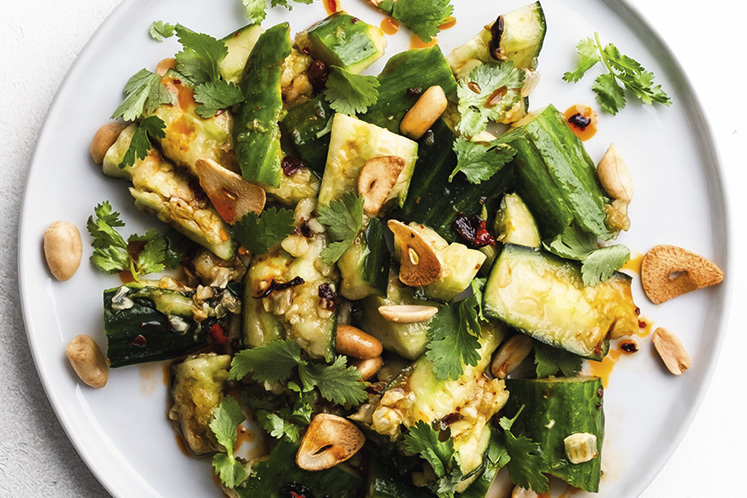
The smashed cucumber salad is bursting with flavours of garlic, cilantro and sesame oil. Photo by Elaine Li.
MAKES 2 SERVINGS
1 long cucumber
¼ cup cilantro, roughly chopped
Optional:a handful of roasted salted peanuts, cashews or sesame seeds
DRESSING
2 tsp vegetable oil
1 clove garlic, thinly sliced
1½ tbsp soy sauce
1 tbsp sesame oil
1 tbsp rice vinegar
1 tsp honey
2 tsp jarred chili crisp (or substitute chili oil)
Make the dressing by heating the vegetable oil in a small frying pan over medium-low heat. Toast the thinly sliced garlic until crispy. Set aside the crispy garlic for garnish. In a small bowl, combine the garlic oil and the remaining dressing ingredients. Set aside.
Cut the cucumber into roughly 2-inch sections. On the cutting board, lay a large knife flat against the cucumber sections and press it with your other hand to smash the cucumber sections until nearly flat. (Be careful not to place your hand on the sharp blade.) Cut into bite-sized pieces. Don’t worry if they’re not uniform. The size and texture of the pieces will vary. Alternatively, you can place the sections in a resealable bag, squeeze out the air to seal, and smash them with a rolling pin.
Combine the smashed cucumbers and dressing, and marinate in the fridge for about 20 minutes. Garnish with cilantro, a handful of roasted peanuts, and the reserved crispy garlic slices.
Laughing Sesame Cookies
“These crunchy, fluffy, nutty and subtly sweet treats are called ‘laughing sesame cookies’ because the deep cracks of the dough balls resemble a laughing face – sending wishes for the new year to be filled with joy and good times,” says Elaine. “They’re typically served with tea, for guests that come to your house to visit during the Lunar New Year celebration. These cookies are best served freshly fried, as the outside is crunchy but inside is still warm and soft!”
MAKES 32 COOKIES
2⅓ cups pastry flour (or 2⅓ cups all-purpose flour plus 1 tbsp corn starch)
½ cup sugar
¼ tsp baking powder
¼ tsp baking soda
¼ tsp kosher salt
1 egg
3 tbsp butter, melted
⅓ cup water
about ½ to ¾ cup sesame seeds
neutral flavoured oil for frying
In a large bowl, whisk together the flour, sugar, salt, baking powder and baking soda.
Pour the wet ingredients into the bowl and mix until just combined (this is a very sticky dough). Cover with plastic wrap and let rest in the fridge for 20 to 30 minutes.
Evenly divide the dough into 32 pieces. Dust your hands with some flour and roll the pieces into roughly ¾-inch balls.
In a small bowl filled with sesame seeds, place a dough ball and swirl around to coat the dough with sesame seeds. Remove it and roll it again in your hands to re-form the shape. Set it aside as you work on the rest.
In a wok or small pot, heat frying oil to about 260–280 F over medium-low heat. Fry the sesame dough balls in small batches for 6 to 8 minutes or until golden brown. To cool, place on a cooling rack over a tray lined with paper towel.
TO AIR FRY: Lightly brush oil on the air fryer tray, place the dough balls on the tray and air fry at 375 F for about 10 to 12 minutes, shaking the basket halfway. Since appliances vary, refer to the manual for timing and temperature guidance.
Timely Takeout
As the generations shift, Elaine says it’s becoming more common for families to eat out for the Lunar New Year instead of preparing traditional dishes from scratch. If you’d like to order something special for the coming festivities, many local restaurants serve cuisine from China, Vietnam, Thailand and the Philippines. Just be aware that some restaurants will be closed for the holiday as families take much-needed time off to be together.
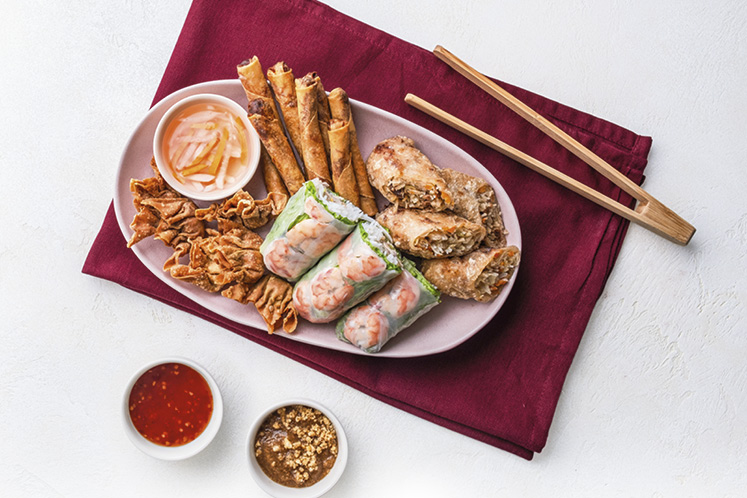
As assortment of spring rolls prepared by Auntie Joy’s Springrolls in Orangeville. Photo by Elaine Li.
ORANGEVILLE
Auntie Joy’s Springrolls and Catering
2-75 First St
auntiejoyspringrolls.com
Guest Wok
47 Broadway
Unit 3
guestwok.com
JB Panda
121 First St
Unit 3B
jbpanda.com
RJ’s Taste of Asia
19 Mill St
rjtasteofasia.ca
Sweet Chili
82 First St
sweetchili.online
SHELBURNE
Happy Dragon Express
226 First Ave East
happydragonexpress.ca
BOLTON
Wah Wi Chinese Restaurant
1 Queensgate Blvd
Unit 6
wahwibolton.com
Panda Garden
301 Queen St South
pandagarden.ca
ERIN
Phở Erin
77 Main St
phoerin.com
MORE INFO
Red Packet Etiquette
During Lunar New Year, elders give small red envelopes, lai see (in Cantonese) or hong bao (in Mandarin), with money inside to younger and unmarried family members, as well as to junior staff at their workplace. (And the use of digital red envelopes via apps such as WeChat is on the rise.) “When I was a child,” recalls Elaine, “we would get so giddy about lai see but we had to try our best not to open the envelope to see how much money was in it, because that’s bad luck – you’re supposed to wait until the 15th day of the celebration!”
Here’s a few of the customs that are followed:
- It’s polite to give and receive the packets with two hands, not one.
- The money that you give should be clean and new, not old and dirty.
- The money should be an even number.
- Avoid the number 4 which is associated with death, so never give $40, or $44, or $400.
- If receiving, don’t open the packet in front of the giver.
Related Stories

Home for the Holydays
Nov 20, 2022 | | CommunityAs the end of year draws near, families and friends gather to celebrate the myriad of traditions, festivals and holy days that are observed in the hills.
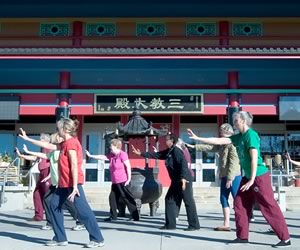
A Path to Stillness, Clarity and Wisdom
Nov 19, 2013 | | Back IssuesThe International Tai Chi Centre in Mono draws people from around the world to practise the ancient art.

